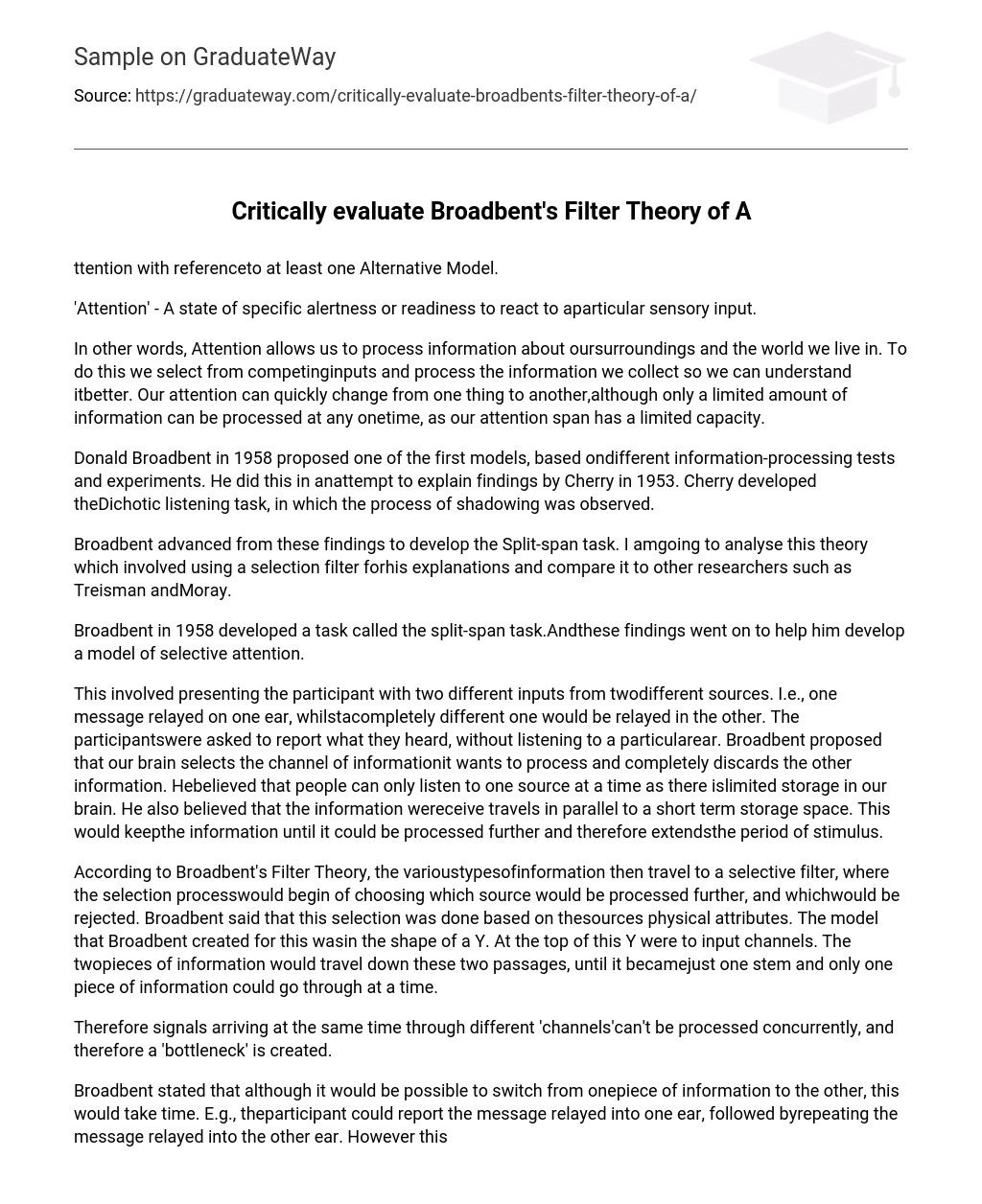ttention with referenceto at least one Alternative Model.
‘Attention’ – A state of specific alertness or readiness to react to aparticular sensory input.
In other words, Attention allows us to process information about oursurroundings and the world we live in. To do this we select from competinginputs and process the information we collect so we can understand itbetter. Our attention can quickly change from one thing to another,although only a limited amount of information can be processed at any onetime, as our attention span has a limited capacity.
Donald Broadbent in 1958 proposed one of the first models, based ondifferent information-processing tests and experiments. He did this in anattempt to explain findings by Cherry in 1953. Cherry developed theDichotic listening task, in which the process of shadowing was observed.
Broadbent advanced from these findings to develop the Split-span task. I amgoing to analyse this theory which involved using a selection filter forhis explanations and compare it to other researchers such as Treisman andMoray.
Broadbent in 1958 developed a task called the split-span task.Andthese findings went on to help him develop a model of selective attention.
This involved presenting the participant with two different inputs from twodifferent sources. I.e., one message relayed on one ear, whilstacompletely different one would be relayed in the other. The participantswere asked to report what they heard, without listening to a particularear. Broadbent proposed that our brain selects the channel of informationit wants to process and completely discards the other information. Hebelieved that people can only listen to one source at a time as there islimited storage in our brain. He also believed that the information wereceive travels in parallel to a short term storage space. This would keepthe information until it could be processed further and therefore extendsthe period of stimulus.
According to Broadbent’s Filter Theory, the varioustypesofinformation then travel to a selective filter, where the selection processwould begin of choosing which source would be processed further, and whichwould be rejected. Broadbent said that this selection was done based on thesources physical attributes. The model that Broadbent created for this wasin the shape of a Y. At the top of this Y were to input channels. The twopieces of information would travel down these two passages, until it becamejust one stem and only one piece of information could go through at a time.
Therefore signals arriving at the same time through different ‘channels’can’t be processed concurrently, and therefore a ‘bottleneck’ is created.
Broadbent stated that although it would be possible to switch from onepiece of information to the other, this would take time. E.g., theparticipant could report the message relayed into one ear, followed byrepeating the message relayed into the other ear. However this could proveto be difficult as discussed earlier, the information is only held in anauditory sensory store, and for this process to work, it would have to bedone in a short enough time for the information not to be diffused. Thismeans that the auditory store would have to retain the information for alonger time, or else it would be lost before it was recognised. Broadbent’stheory can explain Cherry’s findings, as the non shadowed message isn’tallowed to pass through the filter. It can also explain the findings of thesplit span tests, as the ear that the information travels through could bethe physical property of it.
Although Broadbent’s theory was influential, and provided a basis formany researchers to develop further work on, it was incomplete.Gray andWedderburn in 1960 found Broadbent’s model to be inadequate. They reportedfrom replications of the split span tasks findings that showed that meaningplayed a part as well in the selection process. When two three wordsentences were split up, it was usual that the participant would rememberthe meaningful sentence, even though parts of this sentence were relayedthrough different ears.
Moray in 1959 discovered something called thecocktailpartyphenomenon. This is where typically at a party there are many differentconversations going on at any one time. One person would only be involvedin one conversation, but there would hear there name in a separateconversation. The rest of the information would be filtered out, but theirname would pass though the filter. This shows Broadbent’s theory to beinadequate, as meaning obviously does play a part.
Another theory which yet again shows Broadbent’s theory to beinadequate is Triesman. Triesman developed a theory called the Attenuationtheory. This stated that is was obvious that some meaningful informationdid get through the filter, however it maintained that Broadbent’s theorywas also true to an extent that it was filtered on the basis of itsphysical attributes first. This Attenuation Theory stated that instead ofinformation with inappropriate physical characteristics being filtered out,it was simply weakened, or attenuated by the filter. Once information hadpassed through the first filter, where it was either processes or weakened,it would pass through a second- stage analyser, where it would be filteredbased on meaning.
In conclusion, Broadbent’s Filter Theory, was a very influentialTheory, and provided a strong base from which many researchers havedeveloped much more reliable models. It was the first recorded filtertheory, and although it was flawed, and maybe incomplete, it still hadgreat use in society. It is partially supported by Triesman, and withoutthis base of knowledge, we have to ask whether Triesman would have foundthese findings. Therefore, although Broadbent’s theory in not of much usein today’s society, without it, the new research which is being evercreated would not have been possible.
ReferencesGross, R. (2001). Psychology The Science of Mind and Behaviour- FourthEdition. Kent: GreengateHayes, N. (2000). Foundation of Psychology:Third Edition. London: Thomson Learning.
Reed, S. K. (1988). Cognition: Theory and Applications:Second Edition. California: Brooks/ColeSolso, R. L. (2002). Cognitive Psychology:Sixth Edition. Allyn and Bacon





